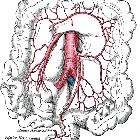Endoleak Typ 1 (Graftende nicht anliegend)







Type I endoleaks are a subgroup of endoleaks which occur at graft ends, often due to an inadequate seal.
Pathology
They occur as a result of poor apposition between one of the attachment sites of a stent-graft and the native aortic or iliac artery wall. Blood can leak through this defect into the aneurysm sac.
They can be seen immediately after stent-graft deployment due to several reasons including
- incomplete dilation of the stent-graft
- aortic tortuosity
- steep aortic angulation
Delayed type I endoleaks may be related to changes in the configuration of the aorta as the aneurysm sac shrinks. These are considered high-pressure endoleaks, and there is a high risk of aneurysm sac rupture because of direct exposure of the aneurysm wall to aortic pressure.
Associations
- most common after repair of thoracic aortic aneurysms
Subtypes
Type I endoleaks can be subdivided into three further categories
- Ia: proximal
- Ib: distal
- Ic: iliac occluder
Radiographic features
Type I endoleaks can be associated with measurable increases in aneurysm sac size.
CT angiography
Preferred imaging modality. Multiphased scanning is helpful. Unenhanced CT may show hyperattenuating acute hemorrhage within the aneurysm sac.
After contrast administration, a dense contrast collection is usually seen centrally within the sac and is often continuous with one of the attachment sites.
Ultrasound
On Doppler sonography, a jet of flow may be seen originating from one of the attachment sites.
Treatment and prognosis
Type Ia leaks
Initial treatment can include balloon angioplasty of the proximal attachment site, aimed at remodeling the stent graft to achieve an adequate seal. If angioplasty is unsuccessful, balloon-expandable bare-metal stents such as Palmaz stents can be deployed over the affected attachment site to promote apposition of the proximal stent graft with the aortic wall.
In cases of undersized or poorly deployed endografts, covered extension cuffs can be used. These can be matched in size and material to the native endograft.
Some newer devices include EndoStaples and EndoAnchors which mechanically attach the proximal endograft with the aortic wall.
Type Ib leaks
Are usually considered easier to manage than Ia leaks, with numerous available iliac extender limbs, covered stents, and bare-metal stents to close the endoleak defect.
Despite advances in endovascular techniques, there are still cases that require surgical repair for definitive treatment.
Siehe auch:
- endovascular aneurysm repair (EVAR)
- Type IV endoleak
- Riolan'sche Anastomose
- Endoleaktypen
- Endoleak Typ 2 (Reperfusion durch Nebengefäß)
- Endoleak Typ 3 (Graftdefekt)
- endoleak type 1b: distal leak at graft attachment site
- Endoleak Typ 5 (Endotension)
- endoleak type 4: a generally porous graft (first-generation grafts)
- endoleak type 2b: aneurysm sac filling via more than one branch vessel
- endoleak type 2a: aneurysm sac filling via single branch vessel
- endoleak type 1a: proximal leak at graft attachment site
- endoleak type 1c: leak at graft attachment site - iliac occluder
- endoleak type 3a: leak through a defect in graft - separation of the modular components
- endoleak type 3b: leak through graft fractures or holes

 Assoziationen und Differentialdiagnosen zu Endoleak Typ 1 (Graftende nicht anliegend):
Assoziationen und Differentialdiagnosen zu Endoleak Typ 1 (Graftende nicht anliegend):



